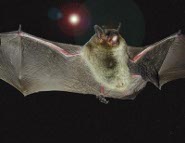 The Gray Bat (Myotis grisescens) is an endangered species of bat which prefers to live in caves, and can be found in the southern United States, and it prefers to live close to water. The bat is usually 8-13g in weight and has a wingspan of nearly a foot (30 cm), additionally it is known for its long distance travel of 8 miles (14 kilometers) from where it sleeps to where it finds food. They are a gray color, which is indicated in their name, and they like to hunt over bodies of water; additionally they have mouse-like ears. They are most commonly found inside of caves that are close to areas of water. Their range extends throughout northern Arkansas, Missouri, southern Illinois, southern Indiana, most of Kentucky, the midland of Tennessee and then down through Alabama into parts of Georgia and Florida at the boarders. Although their population is over a million, it was found through an extensive survey that they likely only live in eight major caves, with one in Arkansas, one in Alabama, one in Kentucky, three in Missouri, and two in Tennessee.
The Gray Bat (Myotis grisescens) is an endangered species of bat which prefers to live in caves, and can be found in the southern United States, and it prefers to live close to water. The bat is usually 8-13g in weight and has a wingspan of nearly a foot (30 cm), additionally it is known for its long distance travel of 8 miles (14 kilometers) from where it sleeps to where it finds food. They are a gray color, which is indicated in their name, and they like to hunt over bodies of water; additionally they have mouse-like ears. They are most commonly found inside of caves that are close to areas of water. Their range extends throughout northern Arkansas, Missouri, southern Illinois, southern Indiana, most of Kentucky, the midland of Tennessee and then down through Alabama into parts of Georgia and Florida at the boarders. Although their population is over a million, it was found through an extensive survey that they likely only live in eight major caves, with one in Arkansas, one in Alabama, one in Kentucky, three in Missouri, and two in Tennessee. Although they number a million and a half, they are endangered due to massive population losses, mostly caused by human action and interference in their habitats. Most of the destruction to their habitat has occurred due to vandalism and disturbances by tourists.
Their binomial name is Myotis grisescens, and they belong to the Genus Myotis, or the Mouse-eared bats. Within this genus there are 90 known species, with 10 living in Europe alone and come in many different sizes. It is thought that some species have yet to be discovered. The Genus Myotis belongs to the Subfamily Myotinae, which has three Genera within it; they are Myotis (the aforementioned Mouse-ear bats), Lasionycteris (a single species in its own Genus) also called the Silver haired bat, and Cistugo which are called the wing-gland bats. Myotinae belongs to the Family Vespertilionidae, or the Vesper Bats; there are five Subfamilies in the Family Vespertilionidae. Vespertilionidae belongs to the Suborder Microchiroptera, of which all the Microbats belong. Microchiroptera belongs to Chiroptera of which the Micro and Megabats (flying foxes, which are large fruit eating bats) belong. Chiroptera belongs to the Superorder Laurasiatheria of which the carnivores, ungulates, moles, and many other orders of mammal belong. Laurasiatheria in turn belongs to Infraclass Eutheria, of which all placental (including humans) are members. This in turn belongs to the Subclass Theira of which all mammals, with the exception of the Monotremes, are members.
Interesting Fact
The Gray Bat is a close relative to the Indiana Bat, which is in the same Genus, and is also endangered. Their territories overlap, and they share many of the same traits – however the Indiana Bat is brown, and there are less than 300,000 left.
Keywords: gray
The Gray myotis, grey bat is listed as Endangered (EN), considered to be facing a very high risk of extinction in the wild, on the IUCN Red List of Threatened Species
Countries
United StatesSome facts about the
Gray myotis
Adult weight : 0.009 kg (0.0198 lbs)
Maximum longevity : 17 years
Female maturity :456 days
Male maturity : 456 days
Litter size : 1
Interval between litters : 365 days
Weight at birth : 0.003 kg (0.0066 lbs)

Custom Search